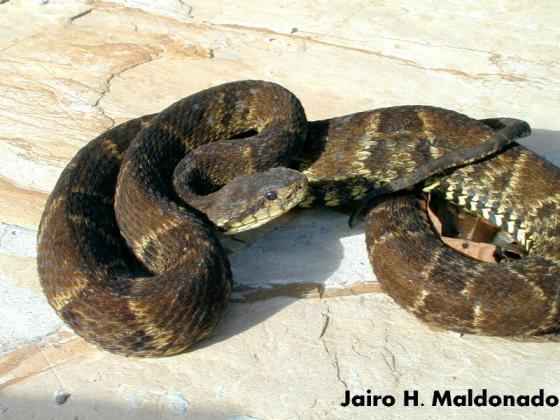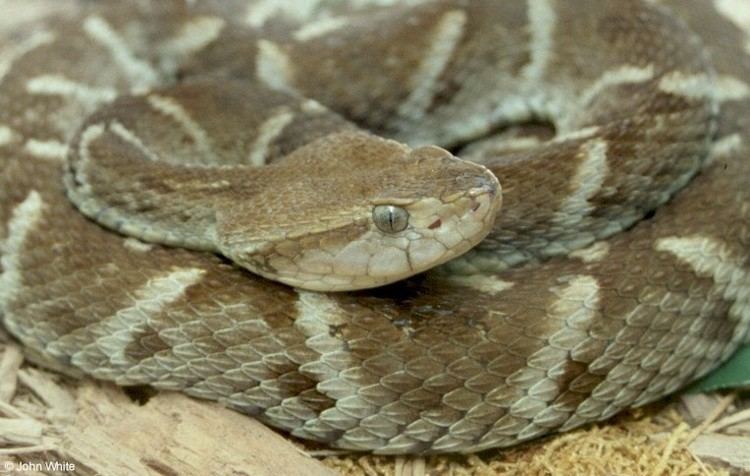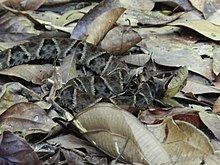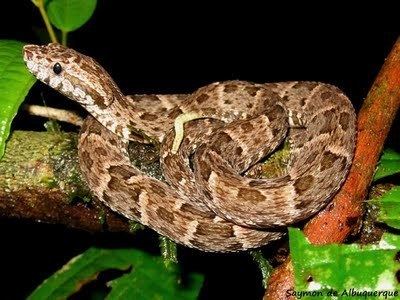Subphylum Vertebrata Suborder Serpentes Scientific name Bothrops atrox Rank Species | Phylum Chordata Higher classification Bothrops | |
 | ||
Similar Bothrops, Snake, Fer‑de‑lance, Vipers, Lachesis muta | ||
Fer de lance bothrops atrox reptile discovery center deland
Bothrops atrox — also known as the common lancehead, fer-de-lance, and barba amarilla — is a species of pit viper found in the tropical lowlands of northern South America east of the Andes. No subspecies are currently recognized.
Contents
- Fer de lance bothrops atrox reptile discovery center deland
- Fer de lance bothrops atrox in the yasuni
- Description
- Common names
- Geographic range
- Habitat
- Behavior
- Feeding
- Reproduction
- Venom
- Taxonomy
- References

Fer de lance bothrops atrox in the yasuni
Description

A terrestrial species, adults usually grow to a total length 75–125 cm (about 30-50 inches) and are moderately heavy-bodied. Reports of the maximum size are not clear, as this species is often confused with B. asper. Soini (1974) mentioned of a series of 80 specimens collected in northeastern Peru, the largest was a female of 138.8 cm (4.55 ft). The largest specimen measured by Campbell and Lamar (2004) was a female with a total length of 162 cm (5.31 ft).

The scalation includes 23-29 (usually 23-25) rows of dorsal scales at midbody, 169-214 and 177-214 ventral scales in males and females, respectively, 52-86 (usually 75 or fewer) subcaudal scales in males, which are usually divided, and 47-72 subcaudals in females. On the head, the rostral scale is about as high, or slightly higher, than it is wide. There are three to 11 (usually five to 9) keeled intersupraocular scales, seven to 13 (usually eight to 11) sublabial scales and six to 9 (usually seven) supralabial scales, the second of which is fused with the prelacunal to form a lacunolabial.

The color pattern is highly variable, including a ground color that may be olive, brown, tan, gray, yellow, or (rarely) rusty. The body markings are highly variable, as is the degree of contrast: in some specimens the pattern is very well defined, while in others it may be virtually absent. In general, however, the body pattern consists of a series of dorsolateral blotches, rectangular or trapezoidal in shape, which extend from the first scale row to the middle of the back. These blotches may oppose or alternate across the midline, often fusing to form bands. They also have pale borders, which in some cases may be prominent, and may be invaded from below by tan or gray pigment, occasionally dividing them into pairs of ventrolateral spots. The belly may be white, cream or yellowish gray, with an increasing amount of gray to black mottling posteriorly that may fade again under the tail. The head usually does not have any markings other than a moderately wide postocular stripe that runs from behind the eye back to the angle of the mouth. The iris is gold or bronze, with varying amounts of black reticulation, while the tongue is black.
Common names
Common names include lancehead, fer-de-lance, and barba amarilla.
The Spanish common name barba amarilla (yellow beard), an allusion to the pale yellow chin color, is also used in English. In Colombia, it is known as mapaná (Llanos of Vichada) and talla equis. In Guyana and Suriname, it is called labaria or labarria. In Peru, it is called aroani (Yagua), cascabel (juveniles), ihdóni (Bora), jergón, jergona, jergón de la selva, macánchi (Alto Marañón), machacú, marashar and nashipkit (Aguaruna names). In Venezuela, it is called mapanare. The jergón name is an allusion to the x-like markings of the color pattern. In Ecuador and Panama, these x-like markings have led to the snake simply being referred to as equis (the Spanish name of the letter 'x'). In Trinidad it is known as mapepire balsain. In Bolivia it is called Yoperojobobo. In Brazil the common names are Jararaca or Surucucu.
Geographic range
This species is found in the tropical lowlands of South America east of the Andes, including southeastern Colombia, southern and eastern Venezuela,the island of Trinidad (although there is some confusion of the systematics of this population), Guyana, Suriname, French Guiana, eastern Ecuador, eastern Peru, Panama, northern Bolivia and the northern half of Brazil. The type locality is listed as "Asia", which is obviously a mistake. Schmidt and Walker (1943:295) proposed this be corrected to "Surinam".
Habitat
Despite the vast destruction of rain forests, it is amongst the most numerous and common of pit vipers and is not endangered. In Trinidad, it prefers wet forests from sea level to 940 m.
Behavior
Although generally terrestrial, it is also an excellent swimmer and even climbs trees when necessary to reach prey. Generally nocturnal, it may forage at any time of the day, though, if necessary. These snakes are also easily agitated.
Feeding
The main diet includes mostly small mammals and birds, but also frogs and lizards. Larger prey is struck and released, after which it is tracked down via its scent trail.
Reproduction
Bothrops atrox can give live birth to up to 80 offspring at once. Adults breed year-round. After mating, females with developing embryos travel in and out of sunlight to keep themselves and the embryos at a constant temperature. In equatorial regions, the gestation period is about three to four months, with an average of 60 young per litter. At birth, the young are about 30 cm (12 in) in total length, more brightly colored than adults, and have yellow or beige tails.
Venom
These snakes are known to search for rodents in coffee and banana plantations. Workers there are often bitten by the snakes, which can lie camouflaged for hours, nearly undetectable, and strike with high speed.
Their venom consists mostly of hemotoxin, a toxic protein that affects the circulatory and nervous system; it destroys red blood cells, and sometimes loss of memory occurs. They are much feared because their venom is particularly lethal and fast acting. Presently, treatment is usually possible if the victim receives medical attention soon enough. Commonly, bites from this snake cause symptoms including nausea, blackouts, and paralysis. In almost all cases, temporary and sometimes permanent loss of local or 'short term' memory were reported. Extended hospital stays, as well as weight loss of up to 15 pounds, have also been reported. Venom yield averages 124 milligrams (1.91 gr), although it may be as much as 342 milligrams (5.28 gr). The enzyme reptilase (batroxobin), derived from this snake's venom, is used in modern medical laboratories to measure fibrinogen levels and blood coagulation capability. The test is considered to be a replacement for thrombin time, and is used when heparin is present in the sample. The enzyme is unaffected by heparin.
Taxonomy
The taxonomy of this species is controversial; it may include B. leucurus and B. moojeni, and some of its populations are sometimes said to be separate species. B. asper was formerly included in this species, but most authorities now consider it distinct.
